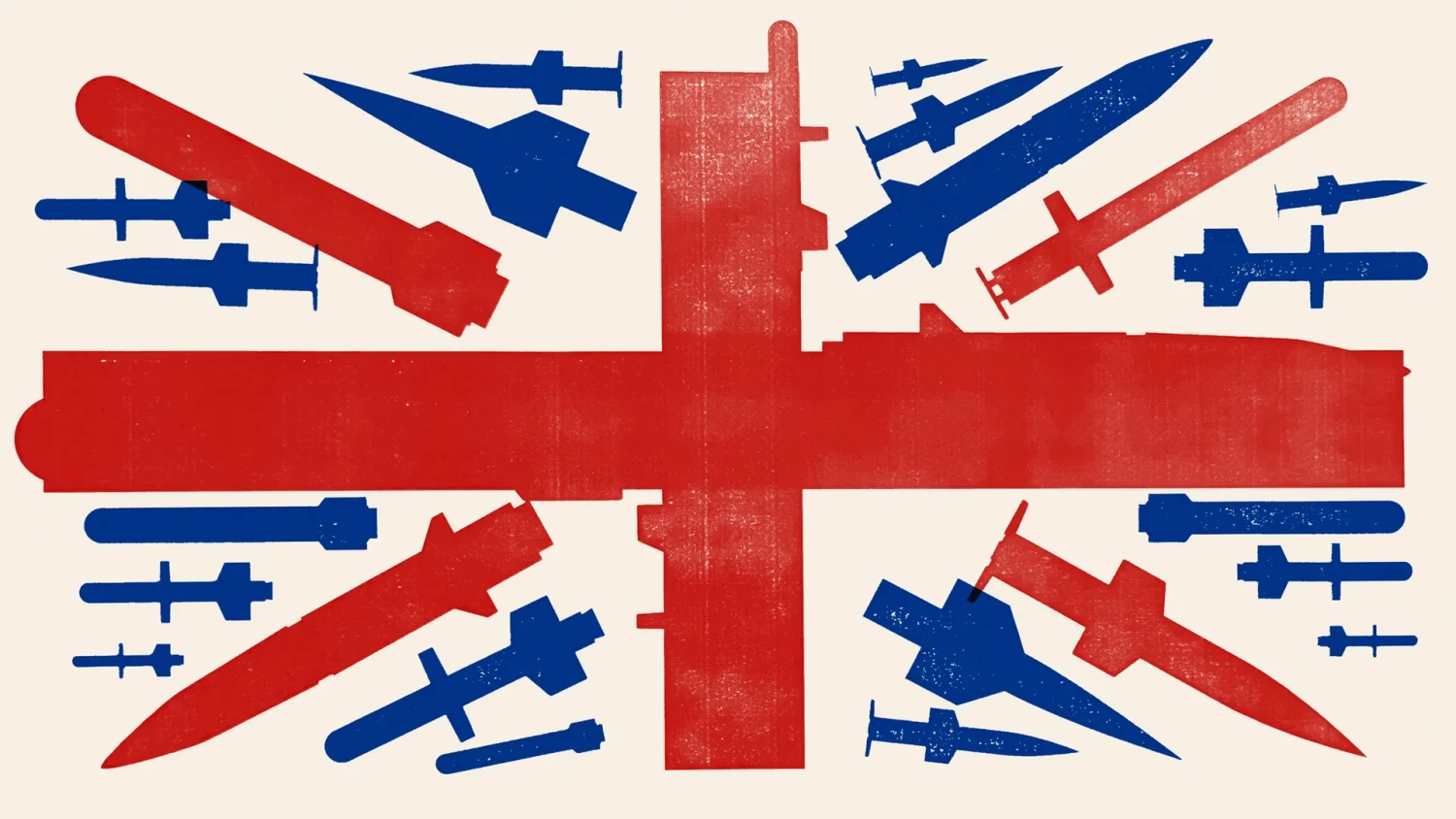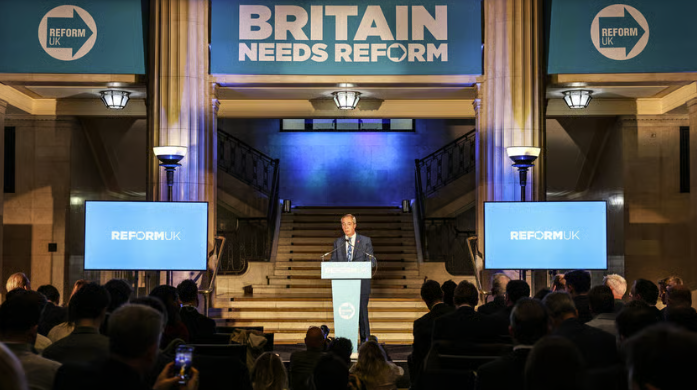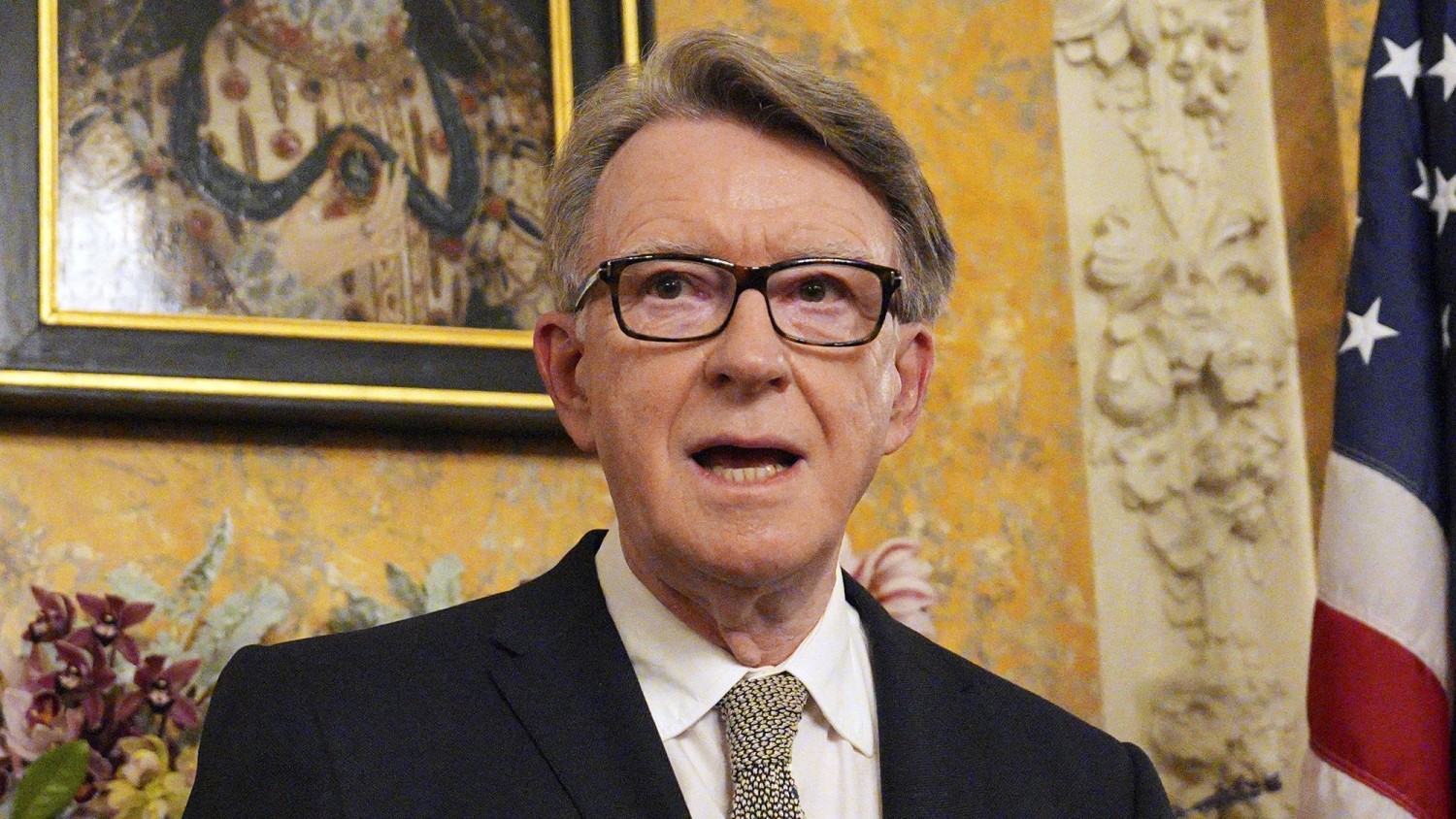
This article is more than
1 year oldBritain’s Embrace of the Bomb

The country’s nuclear-weapons program is in bad shape, yet it is one of only two nations actively rearming. What’s it all for?
At 2:15 a.m. on January 29th, the United States National Geospatial-Intelligence Agency issued a Hazardous Operations warning for a stretch of ocean from the waters off Port Canaveral, Florida, to some empty waves in the middle of the South Atlantic, about a thousand miles off the coast of Liberia. The operation in question was the firing of a Trident-II D5 ballistic missile, which weighs fifty-eight tons, from H.M.S. Vanguard, one of Britain’s nuclear attack submarines. The Vanguard had recently completed a seven-year, five-hundred-million-pound refurbishment and was there to show that it was ready to go back on patrol. Such tests are called Demonstration and Shakedown Operations (dasos). Since the late nineteen-sixties, the United Kingdom’s nuclear arsenal has consisted, principally, of a small fleet of British-made submarines carrying U.S.-made missiles with British plutonium warheads on top. The system is notionally independent, but the entire architecture relies on American good will, and hardware, to function. The Royal Navy owns its Trident missiles much like a time-share; they are drawn from a shared pool at the U.S. Strategic Weapons Facility, in Georgia. dasos are occasions for British and American military bigwigs to catch up over drinks at the hotel—“a mix of a jolly and a reunion,” as a British parliamentary hearing was told in 2017, “with the launch of an intercontinental ballistic missile thrown in.”
There was some pressure for a good show. During the last British daso, in June, 2016, the Trident, instead of heading farther out to sea, took off in the direction of Florida before self-destructing. That mishap, which was the first time a British Trident test had gone wrong since the system entered service, in 1994, was kept secret for six months. For this year’s launch, Grant Shapps, the British Defense Secretary, was on board the Vanguard, as was the First Sea Lord Admiral Ben Key, the head of the Royal Navy. This daso was a damp squib as well. The Sun reported that, after the missile rose into the air from the submerged Vanguard, its boosters did not properly ignite. “It left the submarine but it just went plop, right next to them,” a source told the newspaper. The Trident sank to the bottom of the sea.
Britain’s nuclear weapons have always been an act of misdirection—the assertion of an identity that no one totally believes. During the Second World War, the country’s small but sophisticated atomic-weapons program, known as Tube Alloys, was merged with the Manhattan Project, and Britain sent scientists (including Klaus Fuchs, a Soviet spy) to Los Alamos. In 1946, the U.S. withdrew from nuclear coöperation, leaving the U.K. with the awkward choice of whether to develop a bomb on its own. The decision was always about convincing the Americans—and the British state—of the country’s remaining vitality and power, rather than anything that made a whole lot of military or economic sense. “We’ve got to have this thing over here, whatever it costs. We’ve got to have the bloody Union Jack on top of it,” Ernest Bevin, the Foreign Secretary, reportedly told a secret ministerial meeting in January, 1947, as it considered approving a new weapons program.
In the fifties, the U.K. obliterated Australian deserts and Pacific atolls with atomic and hydrogen bombs of its own design, but its delivery systems—slow-moving aircraft and British-made missiles—were considered unreliable and vulnerable to Soviet attack. In 1958, British and American nuclear coöperation resumed, and in 1962 John F. Kennedy agreed to sell Britain Polaris missiles, which could be launched from Royal Navy submarines. Since Polaris came into service, the U.K. has operated what it calls a Continuous at Sea Deterrent (casd, pronounced “casdee”). Under casd, the U.K. maintains a fleet of four nuclear-equipped submarines, or “bombers,” and insures that at least one is always at sea and, in theory, able to respond to nuclear attack on the U.K. For decades, Britain’s nuclear threat was defined, albeit loosely, by the “Moscow Criterion”—the idea that if the U.S.S.R. ever launched a nuclear attack on the U.K., it would lose its capital city.
casd has never been as vulnerable as it is now. When this year’s failed test became public, Shapps reassured the House of Commons that, over all, the Vanguard’s daso had been a success. “An anomaly did occur,” Shapps acknowledged. “But it was event-specific.” (The gossip among British defense analysts is that the fault was caused by testing equipment, rather than by the underlying technology.) But if nuclear deterrence is mostly about perception, then everyone agreed this was a bad look. “Let’s not pretend. It is very embarrassing,” Admiral Alan West, a former First Sea Lord, told me recently. “Does it mean your system doesn’t work? No. Our system does work. But it is bloody embarrassing.”
It was also, to some extent, foreseen. Everything about Britain’s nuclear-weapons infrastructure—its submarines, missiles, warheads, testing facilities, dockyards, bunkers, an opaque collective known in official documents as “the Defence Nuclear Enterprise”—is aging out. And none of its replacement parts are anything like ready yet. The Vanguard, which fired the faulty missile, has been in service for thirty years—five years longer than it was designed for. In 2010, for a mixture of political and cost-saving reasons, the Conservative-led government delayed ordering a new, thirty-billion-pound successor fleet of submarines for six years, causing a series of knock-on delays throughout the U.K.’s defense supply chain. The first of the new ships, H.M.S. Dreadnought, which was originally supposed to come into service this year, is now not expected until the early to mid-twenty-thirties, and no one is holding his breath. For the past two years, the Infrastructure and Projects Authority, which supervises Britain’s biggest public building programs, has given the new submarines’ nuclear core and fuel development (under the charge of Rolls-Royce) a red rating, meaning: “Successful delivery of the project appears to be unachievable.”
No one is sure that the existing submarines can hold out until the new ones come along. Each year, the repairs to the fleet are more time-consuming and expensive than they were before. (The Vanguard’s recent refurbishment took three years longer than planned.) This, in turn, puts more strain on the boats and crews out below the waves. In March, the Daily Mail reported that H.M.S. Vengeance returned to port after more than six months at sea, the second-longest patrol on record. (In the past, patrols lasted ninety days or so.) While on patrol, bombers stay at a constant depth and move slowly, cut off from the population they defend. They do not transmit messages, which might reveal their location. Boredom is a factor. “It has caused problems,” West said, of the vicious cycle of repairs and extended patrols, “and has caused problems with our people.” In April, 2019, the Royal Navy celebrated fifty unbroken years of Operation Relentless, Britain’s nuclear patrol. I asked West if he was confident that the casd could be maintained for another decade, until the first of the new submarines are ready. “There is no doubt, it is very fragile,” he said. “And that is of great concern.”
For a long time, Britain’s nuclear weapons were a point of political dispute. At the turn of the sixties, the Campaign for Nuclear Disarmament organized annual Easter marches from the headquarters of the U.K.’s weapons program, in Aldermaston, in Berkshire, to Trafalgar Square, in London. Tens of thousands of people marched for four days, almost invariably in the rain. In the eighties, the Labour Party had a policy of unilateral disarmament. In 2016, Jeremy Corbyn, the Party’s former leader (and also a former vice-chair of C.N.D.), voted, with about forty Labour colleagues, against the renewal of the Trident deterrent system. The Liberal Democrats, typically the third-largest party in the House of Commons, were also conflicted, historically. (In 2013, the Party opposed a direct replacement for the existing deterrence, suggesting building three submarines instead of four.)
Apart from the ethical angst caused by the weapons themselves, there has always been the practical question of whether the U.K. has any real sovereignty in these questions, and whether it is worth spending billions and billions of pounds pretending that we do. (“We ought not to give the Americans the impression that we cannot get on without them,” Clement Attlee, the Prime Minister who approved the postwar weapons program, wrote, in 1946.) The British government describes its two hundred and twenty-five-odd nuclear warheads as “a minimum, credible, independent nuclear deterrent.”
But the independence, in truth, is hard to discern. In the 1962 Polaris deal, which continues to frame the arrangements, President Kennedy stipulated that the missiles bound for Britain were for the defense of Western Europe as a whole “except where H.M.G.”—Her Majesty’s Government—“may decide that supreme national interests are at stake.” In other words, Britain is a client state, albeit a senior one, with certain privileges. This power dynamic remains. In early 2020, Britain’s decision to build its first new warhead in thirty years—which had not been announced, or, still less, debated in Parliament—was accidentally revealed in a U.S. Senate hearing. In his memoir, Tony Blair, a C.N.D. member in his youth, wrote that it was “frankly inconceivable we would use our nuclear deterrent alone, without the US,” and admitted that he hesitated over the original decision to renew the Trident system, back in 2006.
Such doubts are long gone now. Ahead of next month’s general election, only the Scottish National Party has anything skeptical to say about the Enterprise. The rest of the country’s politicians compete in their dedication to the cause. The Lib Dems are on board. Keir Starmer, Corbyn’s successor as Labour leader and almost certainly Britain’s next Prime Minister, is always looking for opportunities to show how serious he is. Starmer’s two big words during the election campaign so far are that Britain is ready for a “change” from the Conservatives and that people should vote for his “changed” Labour Party. Nuclear weapons are an easy way for Starmer to put some distance between himself and Corbyn. In April, he visited a submarine shipyard in Cumbria and described his commitment to the nuclear deterrent as “unshakable, absolute, total.” Last week, he announced “a nuclear-deterrent triple lock,” promising that a future Labour government would continue the submarine-building program, maintain casd, and guarantee the “delivery of all future upgrades” for the Enterprise.
In practice, this means nuclear rearmament. In 2021, under Boris Johnson, the U.K. stopped reducing its weapons stockpile and became the world’s only nuclear-armed country apart from China to openly rearm—with a plan to add up to eighty warheads, an increase of some forty per cent, by the mid-twenty-twenties. The official military reasoning includes “a developing range of technological and doctrinal threats.” In other words, as Vladimir Putin threatens the use of tactical nuclear weapons in Ukraine and China bristles next to Taiwan, with Donald Trump appearing likely to return, a nuclear deterrent that used to be “minimum” and merely “credible” isn’t so “minimum” and “credible” anymore. The Moscow Criterion is no longer sufficient.
Nevertheless, a belief in the need for Britain’s nuclear weapons, however fervent, does not mean that the weapons are in good order. When I spoke to David Cullen, the director of the Nuclear Information Service, a nonprofit that scrutinizes the U.K.’s weapons infrastructure, he described a “huge discrepancy between the actual functioning state of the program and the political discourse about it.” He went on, “The three largest U.K. parties are committed to the status quo in a way that just has not been the case for a very, very long time. And yet, the status quo may not be sustainable.” For those who keep an eye on the Enterprise (a challenging task, given the level of secrecy involved), the past decade has provided a series of partial, worrying glimpses into a Cold War-era program grappling with advanced entropy.
In 2012, operations at A45, an enriched-uranium storage-and-manufacturing facility at the Atomic Weapons Establishment in Aldermaston, were suspended for three years, because corrosion was found in the steel of the fifties-era structure. Project Pegasus, which was intended to replace the A45 facility, is not expected to be fully operational until 2030—fourteen years late. A parallel development, Project Mensa, a nuclear-warhead facility in Burghfield, a village down the road, was expected to open this year, seven years late and more than £1.2 billion over budget. But that hasn’t happened yet. It is a story that repeats. “I fear that what has happened cumulatively over a number of years is lots of little things have been allowed to slide,” Andrew Futter, a professor at the University of Leicester, who writes about contemporary nuclear affairs, told me. “There’s not a cheap way of doing this stuff.” Last year, the National Audit Office reported that the costs of maintaining and replacing the country’s nuclear deterrent had risen by an estimated fifty-four billion pounds by 2033, to a cool hundred billion, or around seventeen per cent of the entire defense budget. (In the U.S, about 7.5 per cent of defense spending is on nuclear forces.)
None of this is secret. In March, Rishi Sunak’s Conservative government published a paper describing the renewal of the country’s nuclear-weapons infrastructure as “A National Endeavour”—“some of the largest and most complex programs ever seen.” Together, the construction of the new submarines, nuclear reactors, and warheads dwarfs any single public-infrastructure project in the U.K. (Previously, the government has compared the renewal program to HS2, the ill-fated, hundred-billion-pound high-speed railway that was partly cancelled last year, because of ballooning costs and delays.) There is nothing about the running of the Enterprise in recent years that should inspire any confidence at all. “It is a huge thing. It’s on the very limit of the scientific, engineering, and technical capability of our nation,” Lord West, who is a strong advocate of the renewal program, said. “I think an awful lot of people in Britain don’t understand that.”
The general election on July 4th is shaping up to be an enormous change in Britain’s ruling dispensation. Starmer’s Labour Party is on course for a huge victory and a return to power after a long fourteen years of slipshod and cavalier Conservative administrations. This change could, and should, finally allow a period of honest reflection about Britain’s internal conditions and place in the world, after years of economic stagnation, the tumult of Brexit, and a partial awakening about the legacies of the British Empire and the country’s once formidable power. It is curious that the nation’s nuclear-weapons program—which appears to be simultaneously falling apart and expanding—barely makes it into the conversation. It’s taken for granted, perhaps, that we’ve got to have the bloody Union Jack on top of it. We’re too scared to let it go.




